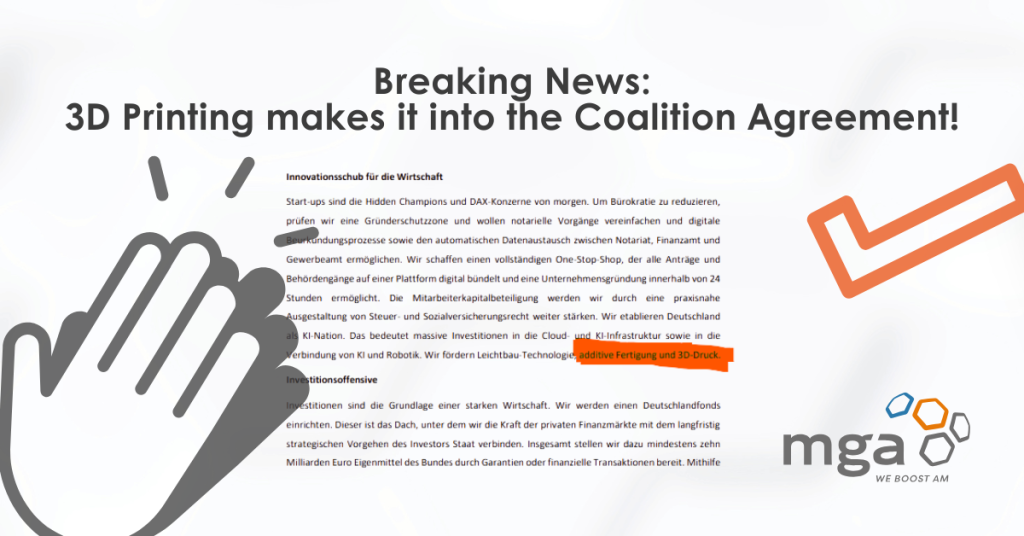It’s official: Additive Manufacturing is finally getting the political recognition it deserves. The new coalition agreement explicitly names 3D printing as a key technology to be strengthened in the coming legislative period. It’s just a line in a policy paper – but one that marks a major step forward.
At Mobility goes Additive, we see this as much more than a political gesture. It’s a signal that our shared efforts are paying off. For years, our network has worked tirelessly to raise awareness for the transformative potential of AM – in healthcare, mobility, energy, and beyond. We’ve shown how 3D printing strengthens European resilience, drives sustainable innovation, and boosts strategic sovereignty.
This recognition didn’t come out of nowhere.
Behind the scenes, we’ve done what strong networks do best: coordinating voices, sharing knowledge, and advocating for change. One of the most impactful contributions to this effort has been the joint position paper developed under the umbrella of the Germany Makes initiative – which we helped initiate. This paper was not created in isolation: it was a collaborative effort shaped by all five regional AM hubs – Munich, Dresden, Berlin, Hamburg, and Aachen – working together to bring our shared vision and demands to the table.
Our original MGA position paper served as a foundation for this broader document, and it’s on this joint basis that we’re determined to take the next strategic steps.
The position paper outlines five key priorities that must be addressed if AM is to become a true pillar of European industrial strategy:
- Integrating AM into industrial policy
AM is more than just a production method — it’s a cross-sectional, enabling technology. We need coordinated strategies at the EU and national levels that reflect its relevance for digitalisation, sustainability, and resilience. - Investing in infrastructure and innovation
From funding research to scaling up production capabilities, Europe must commit to long-term support and lighthouse projects that take AM from prototypes to mass production. - Strengthening education and workforce development
Skills are the foundation of progress. We advocate for AM to be systematically integrated into training programs, universities, and upskilling initiatives. - Accelerating standards and certification
Without clear pathways for approval and certification, innovative AM solutions can’t reach the market — especially in regulated sectors like healthcare. Harmonised, agile processes are urgently needed. - Driving sustainability through AM
Additive Manufacturing can lead the way in decentralised production, resource efficiency, and circularity — but only if the right political and economic incentives are in place.
These recommendations were actively shared with political stakeholders, integrated into consultations, and discussed across multiple forums – always with one goal in mind: to secure real momentum for AM at the policy level.
So yes – we’re proud to say it: this line in the coalition agreement is no coincidence. It’s the result of persistent, collective advocacy. And it proves that when our community works together, we can move the needle.
But let’s be honest – this is just the beginning.
Now that AM has made it into the political conversation, we need to keep it there. We need concrete steps: investment programs, strategic roadmaps, harmonised regulations, and meaningful partnerships across industry, academia, and government.
As our Managing Director Stefanie Brickwede puts it:
“We’re at a tipping point. Additive Manufacturing can be a driver of competitiveness in Europe — but to realise that, we need the right political and industrial framework. That’s why we wrote this position paper, and why we’ll keep pushing.”
Our message to policymakers is clear:
If you’re serious about future-proofing our industries, ensuring technological sovereignty, and strengthening Europe’s competitive edge, then you need to include AM in your plans – not just as a footnote, but as a cornerstone.
This new coalition paper gives us the opening we’ve been working toward. Now, it’s time to build on it.
At MGA, we’ll continue to act as a bridge between politics and practice – and we invite all our members and allies to do the same. Let’s use this moment to engage, align, and act.
Together with Germany Makes and our fellow hubs, we can shape an AM ecosystem that is innovative, competitive, and resilient!
